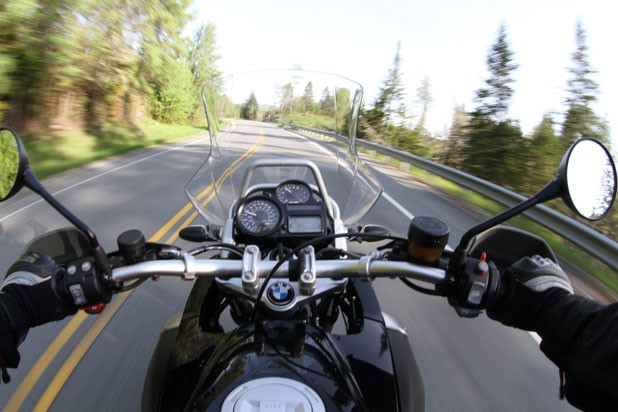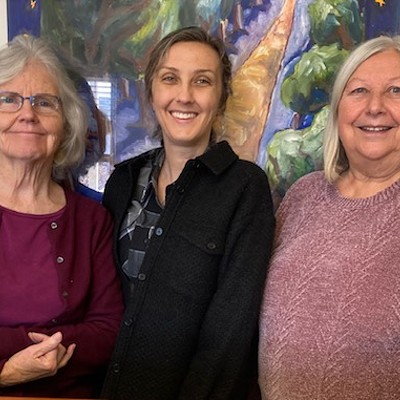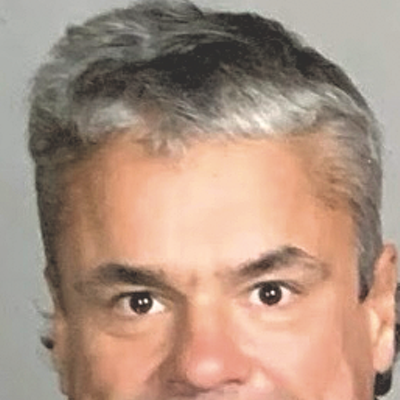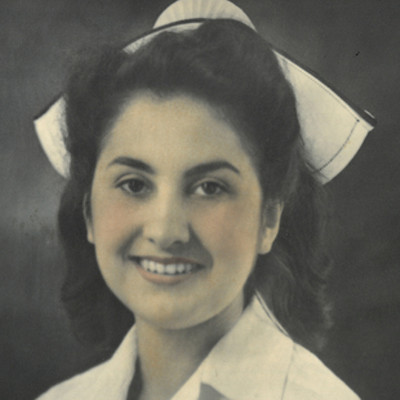
Eric Milano perches atop a gleaming BMW R 1200 GS. He accelerates as he leaves behind the gridlock of midday traffic in South Burlington, but within moments he’s slowing down to navigate Governor Chittenden Road, a shady dirt path that meanders under lush foliage and past small dairy farms.
It’s vistas like this that Milano hopes will convince dedicated motorcycle tourists to make Vermont their next destination. Banking on the state’s scenic appeal from the back of a motorbike, he launched MotoVermont — the state’s first motorcycle touring company — last year.
“I love motorcycling, and I think it’s a really unique way to experience a place,” says the avid rider.
His timing was perfect. Milano’s business goes hand in glove with what are now the two fastest-growing segments of motorcycle culture: dual-sport riding (which combines riding on dirt and paved roads) and adventure touring. Data from the Motorcycle Industry Council show that sales spiked last year among touring bikes (up 13.5 percent since 2010), dual-sport bikes (up 14.2 percent) and traditional motorcycles (up 11.7 percent from the previous year).
But, even as motorcycle touring has grown in popularity across the United States, enthusiasts such as Milano say Vermont has been slow to capitalize on the trend, and that the state could, and should, be doing more to attract motorcycle tourists.
He hopes to fill the gap: MotoVermont is designed to be a one-stop shop for those visitors. Milano’s company, tucked in a garage behind Enterprise Rent-A-Car in South Burlington, provides free pickup and drop-off for customers from the nearby airport. For between $99 a day for a lightweight Kawasaki and $179 a day for the most luxurious BMW, Milano will outfit a motorcyclist with all the essential gear and custom-tailored routes for exploring Vermont’s roadways.
As Milano takes off in the direction of Underhill, I’m balanced behind him on the passenger seat. This is my first time, ever, on a motorcycle. I figure the statute of limitations is well up on my mother’s dear-God-never-get-on-the-back-of-a-motorcycle directive, and I’ve put on a show of derring-do about the whole affair despite some jitters.
I shouldn’t have worried. Though I’m admittedly white-knuckling the handles on either side of my seat, sitting behind an experienced rider turns out to be more thrilling than terrifying. When we slow down to glide through village centers — past kids eating creemees and farmers bringing in hay — my line of thought isn’t, I feel like a bobble head in this helmet or I could die at any moment. It’s more like, I feel really rad right now.
Milano moved to Vermont 10 years ago, and by now knows its back roads well. He was working for an electronics recycling company based in Miami when he was offered the option to telecommute. Suddenly, Milano could work anywhere in the country. He picked Burlington — in part because of its relative proximity to his native New York City but also because he loved Vermont’s beauty.
It was around the same time that Milano took up motorcycle riding (after trying his gateway hobby, snowmobiling). “I was actually always kind of scared of motorcycles,” he reveals, but, like many riders, he got hooked after he gave riding a whirl. Milano admits it can be a dangerous hobby. According to the U.S. Department of Transportation, the rate of motorcycle deaths nationwide has been increasing — in part because of the surge in ownership, especially among older riders. Per vehicle mile traveled in 2004, motorcyclists were about 34 times more likely than car passengers to die in a crash and eight times more likely to be injured.
Milano isn’t foolhardy, but, in his estimation, “I think the risk is worth it.”
His customers have to confront that risk head-on when they sign a thick liability disclosure agreement before heading out to explore Vermont’s winding roads. Renters must be at least 25 years old and have a valid motorcycle endorsement on their driver’s license.
Milano’s business is the first devoted primarily to motorcycle rentals in Vermont. Harley-Davidson dealerships, of which there are two in the state, have always rented out bikes — but Bob LoCicero, who runs the website www.motorcycle-vermont.com, says, “The people who would rent Eric’s bikes probably wouldn’t rent a Harley, and vice versa.” Harleys, he says, are “more traditional,” with fewer capabilities and a more limited market appeal — better known for cruising on wide, open roads than for navigating backcountry lanes.
Milano’s business is catching on. Last year, he says, was in many ways a trial run — and he’s already had renters from as far away as India, Denmark and Japan. He’s had plenty of domestic riders, too — everyone from business travelers who want to get out and explore, to couples setting off on New England road trips.
Among the many reasons Milano likes riding in Vermont, he says, is that automobile drivers here are willing to share the road — an important consideration, given that more than half of all motorcycle accidents involve another vehicle.
“The drivers here are extremely respectful,” Milano says. He speculates that it’s because “Vermonters have [an] adventurous side.”
Milano is not alone in his opinion that Vermont is a great place to ride a motorcycle; LoCicero asserts that it’s the best in New England. Riders can follow long stretches of road through rural landscapes without having to change speed too frequently. Even during peak seasons such as fall foliage, LoCicero says, plenty of roads remain lightly trafficked. All the factors that make Vermont attractive to tourists in general — friendly people, scenic views, great food — attract motorcyclists, too, he points out.
But, while other tourists may not worry about the quality of Vermont’s roads, that means everything to motorcyclists: Good roads are to bikers as good snow is to skiers, LoCicero explains. He believes the state should recognize that maintaining its infrastructure is crucial to the tourism industry, as well as to its residents. He points to the Route 17 Appalachian Gap road as an example.
“It’s a motorcycle destination,” LoCicero says. But the road quality has deteriorated so much, he notes, that he thinks it’s dangerous and won’t recommend it to other riders anymore. “That should be a treasured road,” he laments.
Milano agrees, and points to the App Gap as a fantastic road for riding when it’s in better condition. Now, though, he’s sending his riders on alternate routes.
Leaving aside its infrastructure issues, LoCicero says that Vermont is well positioned to take advantage of motorcycling trends. More than half of the state’s roads — 8000 of 14,000 total miles — are unpaved. (Some, he jokes, “qualify as barely paved.”) For dual-sport riders, that’s a great mix.
But LoCicero isn’t convinced that the state of Vermont recognizes what a boon motorcycling could be to the tourism industry. Snowmobiling, he says, gets far more attention, even though the winter recreation season is much shorter. The state’s official tourism website — vermontvacation.com — makes no mention of motorcycling in Vermont. LoCicero wants that to change.
Motorcycling is “overlooked as this distinct thing that has its own attraction,” he says. “Outside the state, we are probably better understood as a motorcycle destination than inside the state.”
Increasingly, however, innkeepers are realizing that motorcyclists can be a valuable source of business. Carina Thorsson owns the Gray Ghost Inn on Route 100 in West Dover. Located beside a ski resort, the inn gets most of its business during the winter months — so when Thorsson noticed the motorcyclists traveling up and down Route 100, she decided to recruit them during the slower summer season.
She contacted Harley Owners Groups, or “hog chapters,” and began marketing her inn as “motorcycle friendly.” Word spread quickly, and soon chapters were planning destination rides up to the inn. They come for a weekend, take day trips from West Dover, and then head home on Sundays.
“It’s just a fantastic group of people,” says Thorsson. She says the stigma sometimes attached to motorcycling doesn’t belong on the riders she sees, most of whom come on Harley-Davidsons, BMWs or Honda Goldwings — expensive bikes that tend to be favored by middle-aged riders. Her experience catering to motorcyclists has been nothing but positive.
“Once people find out that some place or some state is motorcycle friendly, they’ll come, without a doubt,” Thorsson says.
Milano hopes so, too. Our half-day ride peaks in the hairpin turns of Smugglers’ Notch. High in the mountains above Jeffersonville and Stowe, the air is cool and fragrant, the road shaded by the dense forest and dramatic rock cliffs. From here, it’s downhill as we wend our way back to South Burlington and the heat of the city. When we pass a pick-your-own berry farm, we’re enveloped in the smell of fresh strawberries.
“This is a motorcycle nirvana,” Milano says. And, even on one of the hottest days of the summer, it’s hard to disagree.
Jesse Schloff Photography








Comments
Comments are closed.
From 2014-2020, Seven Days allowed readers to comment on all stories posted on our website. While we've appreciated the suggestions and insights, right now Seven Days is prioritizing our core mission — producing high-quality, responsible local journalism — over moderating online debates between readers.
To criticize, correct or praise our reporting, please send us a letter to the editor or send us a tip. We’ll check it out and report the results.
Online comments may return when we have better tech tools for managing them. Thanks for reading.